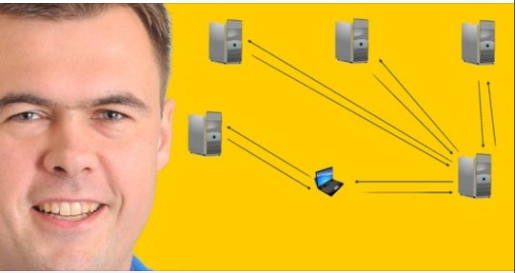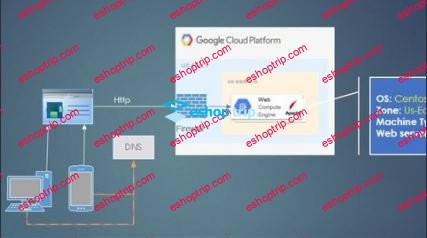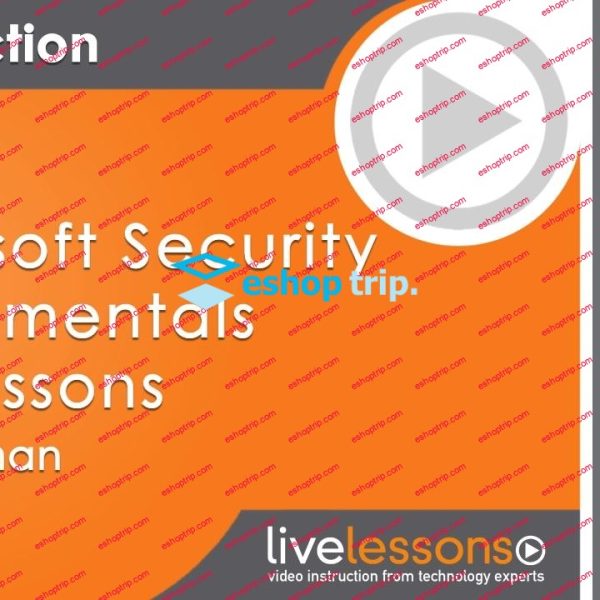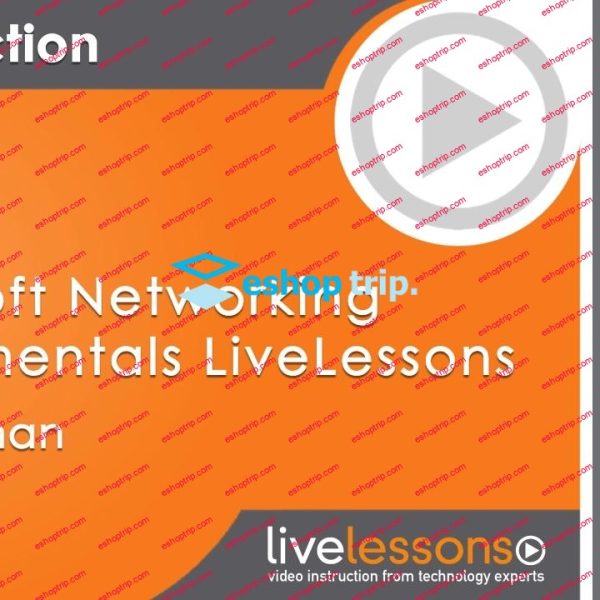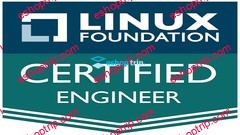Published 11/2024
Created by TechKnowSurge (Andrew Grimes)
MP4 | Video: h264, 1280×720 | Audio: AAC, 44.1 KHz, 2 Ch
Genre: eLearning | Language: English | Duration: 33 Lectures ( 3h 54m ) | Size: 3.93 GB
Understanding IPv6 Addresses, Packets, and Protocols
What you’ll learn
Identify Key parts of an IPv6 Address
Compress and expand an IPv6 Address
Explain IPv6 address types and their purpose
Identify IPv6 Multicast ranges and explain their purpose
Explain the role that a Link Local Address (LLA) has in IPv6 communication
Describe parts of an IPv6 Packet header and their purpose
Explain methods that will help a smooth transition from IPv4 to IPv6
Describe the purpose of Neighbor Discovery Protocol (NDP)
Explain the purpose and process of neighbor solicitations and advertisements
Explain the purpose and process of Duplicate Address Detection (DAD)
Explain the purpose and process of router solicitations and advertisements
Demonstrate how to assign a static IPv6 address on a Windows and Linux machine
Describe the process a machine uses to configure an IPv6 address on a machine using StateLess Address Auto-Configuration (SLAAC) protocol
Demonstrate ability to subdivide (subnet) IPv6 address ranges to meet network requirements
Requirements
no prior knowledge needed for this course
Description
This course provides a comprehensive introduction to Internet Protocol version 6 (IPv6), the latest version of the Internet Protocol that underpins modern network communication. Designed for IT professionals and network engineers, the course covers the essential concepts, structure, and functionality of IPv6. Participants will explore IPv6 addressing, routing, and the differences from IPv4, as well as transition strategies and best practices for implementing IPv6 in diverse network environments.Key components of the course include:Identify Key parts of an IPv6 AddressCompress and expand an IPv6 AddressExplain IPv6 address types and their purposeIdentify IPv6 Multicast ranges and explain their purposeExplain the role that a Link Local Address (LLA) has in IPv6 communicationDescribe parts of an IPv6 Packet header and their purposeExplain methods that will help a smooth transition from IPv4 to IPv6Describe the purpose of Neighbor Discovery Protocol (NDP)Explain the purpose and process of neighbor solicitations and advertisementsExplain the purpose and process of Duplicate Address Detection (DAD)Explain the purpose and process of router solicitations and advertisementsDemonstrate how to assign a static IPv6 address on a Windows and Linux machineDescribe the process a machine uses to configure an IPv6 address on a machine using StateLess Address Auto-Configuration (SLAAC) protocolDemonstrate ability to subdivide (subnet) IPv6 address ranges to meet network requirementsExplore the Mysteries of Internet Protocol version 6 (IPv6)Understand how IPv6 addressing works and is subnettedTake a deep dive into Neighbor Discovery ProtocolSee the important role ICMP packets play in IPv6Learn it Right, Learn it Well, and Reap the RewardsSpending the time now to fully understand the core information of cryptography principles will help create a strong foundation to build off of.Who Should Take this Course:Those who are studying for an IT certification exam, to include A+, Network+, CCNA, Security+, CISSP, Server+, and ITF+Those who who are new to the IT field or trying to get into an IT careerAnyone who wants to have a better understanding of IPv6System administrators, system engineer, network administrators, network engineer, system architects, network architects, help desk techniciansWhy take the course from me?Experience: I’ve been in the IT world since 2000, have a masters in computers, and over 20 industry standard certificationsKnow how to Teach: I was trained as an instructor by the USAF, have a bachelors in education, teaching since 1997, and well over 6,000 hours of classroom instruction time.I’ve been a hiring manager since 2010, I know what skill sets employers are looking for.TechKnowSurge’s Unique ApproachYour instructor has training and years of experience as an educator, as a technician, and as a leader. The course implements the following features:Microstep lectures and segmented videos that meters learning into bite size chunks. It also makes it easy to go back and review concepts when needed.Staged-Based Educational Model where information is covered multiple times in increasing amounts of complexity. The approach helps reinforce learning and creates a knowledge and skill set less likely to fade with time.Extensive coverage of topics to make sure topics are explained fullyWell-organized content. A tremendous amount of effort has been placed on what order content should be delivered to maximize learning and minimizing confusion.A focus on pedagogy. A funny name, but your instructor has a deep understanding of educational theory and what drives learning.Module overviews explaining what to expect for each module and sets a mindset for why the information is important to learn.Video intros, overviews, and summaries to explain the intention of each video, reinforce learning, and prepare you for success.High quality and engaging videos that use graphics, great explanations, and analogies to explain complex topics in an easy to understand way.Real world application. Step beyond just the theory. Your instructor has real world experience and will share that with you throughout the course.Employer insight, know what employers are looking for. Your instructor runs IT Departments and hires individuals just like you.Content and OverviewWhether you are going for a certification, trying to break into a career in IT, or want to advance your career, IPv6 is a fundamental part of the knowledge required for success. Get ready to level up your game. Join us now and let the cryptographic fun begin!This well organized course will has the following modules:Welcome and Getting Started: Prepare yourself for efficiently and successfully completing the course. You’ll get an overview of what the course is all about and what you should expect out of it.IPv6 Addresses: This module delves into the core of IPv6 addressing, providing a detailed exploration of the structure, types, and functions of IPv6 addresses. Participants will learn about the expansive address space that IPv6 offers, how it differs from IPv4, and the various types of IPv6 addresses that facilitate unique and efficient network communication. The module will cover essential topics such as unicast, multicast, and anycast addressing, as well as special addresses like link-local and unique local addresses.Packets and Routing: This module covers the basics of IPv6 packets, which are the fundamental units of data transmission in a network. You’ll learn about the structure of an IPv6 packet, including the main header. We’ll break down how packets are organized, what information they carry, and how they differ from IPv4 packets.Neighbor Discovery Protocol (NDP): NDP is a critical part of how IPv6 functions. This module introduces the Neighbor Discovery Protocol (NDP), a key part of how devices in an IPv6 network communicate with each other. You’ll learn how NDP helps devices find each other, resolve IP addresses to MAC addresses, and maintain accurate information about their neighbors. We’ll cover the main functions of NDP, including address autoconfiguration, neighbor reachability, and router discovery.Assigning IPv6 Address: This module covers the basics of assigning IPv6 addresses to devices in a network. You’ll learn different methods for assigning addresses, including manual configuration, Stateless Address Autoconfiguration (SLAAC), and Dynamic Host Configuration Protocol for IPv6 (DHCPv6).IPv6 Subnetting: This module introduces the concept of subnetting in IPv6, a crucial skill for organizing and managing IP address space efficiently. You’ll learn how to break down an IPv6 address into subnets, understand the role of prefixes, and how to assign subnets within a network. We’ll simplify the process of subnetting, making it easy to apply in real-world scenarios, and provide practical examples to help solidify your understanding. These videos will require some understanding of binary numbers and hexadecimal numbers. There are two modules added in case you need to learn or a refresher on those two subjects.Appendix – Binary Numbers: Supplemental information if you need it to understand IPv6 Subnetting.Appendix – Hexadecimal Numbers: Supplemental information if you need it to understand IPv6 Subnetting.Wrap Up: Time to wrap up the course and provide any final thoughts.Instructor BioTechKnowSurge (Andrew Grimes) has been in the tech industry since 2000 and even longer as an Instructor. He started out as a Survival Instructor for the United States Air Force (USAF) in 1997. When he got out of the military, he started teaching computer classes. Wanting to advance his technical skills, he became a contractor working on a wide range of technologies while teaching technology college courses in the evening. Overtime, he became a hiring manager, director, and leaderHis background includes:Building a security program within 2 years to include becoming SOC 2 Type 2 compliantLeading and maximizing efficiency of IT, Security, and DevOps teamsManaging SaaS company infrastructure with millions of active usersManaging small, medium, and large IT InfrastructuresMigrating technologies to the cloudManaging multi-million dollar budgets and reducing overall budget spend year over yearUtilizing various project management techniques such as waterfall, scrum and Kanban to maximize efficiency and successBachelors in Workforce EducationMasters in Computer Resource and Information ManagementOver 6,000 hours of teaching experienceOver 20 industry standard certifications.Past student reviews:“Andrew is absolutely the best instructor I’ve had throughout the course of my education. He is extremely knowledgeable when it comes to all things network and IT-related. Because of the education he provided, I am now working in the network engineering field, and I could not have done it without his expert guidance.” ~Michael B.“Andrew was hands down my favorite instructor since enrolling” “He has great skills as an instructor, and I’ve learned a lot from his classes.” ~Jeff S.“As an instructor, he is thorough, articulate, patient and positive. He genuinely cares that his students fully comprehend the curriculum. I have a great deal of respect for Andrew. I can’t recommend him highly enough.” ~Dan H.“I found Andrew to be one of the best Instructors” “He presents the information with real world applications, which helped to reinforce the concepts presented in the Cisco Certification track.” “I am truely thankful to have had him as my teacher.” ~Dan M.“Andrew is very knowledgeable and brings his practical business experience with him. He expresses himself very well and treats everyone with respect. He explains very complicated concepts in a manner that is easy to understand.” “It is without reservation that I would recommend Andrew as a business professional and/or teacher.” ~Adam C.“Andrew is an excellent instructor and more.” “Andrew is the kind of teacher that you never forget.” ~ William C.“Andrew Grimes is a first rate instructor who genuinely cares about the success of his students. I was fortunate to have Andrew as my instructor.” “I highly recommend Andrew as an instructor and IT professional.” ~Paul C.“Andrew is a great instructor who really cares whether his students grasp the concepts he teaches. He has a passion for teaching that many couldn’t muster.” ~Patrick R.“He was a great teacher and I would gladly take a class under him again.” ~Joshua R.“…his style of teaching is accommodating for any level, that a student is starting off at, either beginning or advance in IT world.” ~Paul W.“He fosters a multidimensional environment of learning in which students of diverse abilities excel.” ~Mark B“Andrew Grimes was a great Data Networks and Telecommunications Instructor.” “I would highly recommend him to any who desires to further their education.” ~ Tommy S.PrerequisitesNo prior knowledge needed, although some understanding of networking is helpfulEquipmentNo specific equipment needed
Who this course is for
Those who are studying for an IT certification exam, to include A+, Network+, CCNA, Security+, CISSP, Server+, and ITF+
Those who who are new to the IT field or trying to get into an IT career
Anyone who wants to have a better understanding of IPv6
System administrators, system engineer, network administrators, network engineer, system architects, network architects, help desk technicians
https://anonymz.com/?https://www.udemy.com/course/foundation-of-ipv6/





